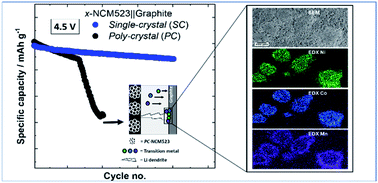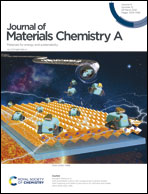Prospects and limitations of single-crystal cathode materials to overcome cross-talk phenomena in high-voltage lithium ion cells
Abstract
The specific energy of lithium ion batteries can be further enhanced by increasing the cell voltage (>4.3 V). However, conventional cathode active materials (CAMs) e.g. LiNi0.5Co0.2Mn0.3O2 (NCM523) with typical poly-crystal (PC)-based secondary particles suffer from rollover failure at 4.5 V, which is shown to be the result of an electrode cross-talk, i.e., dissolution of transition metals (TMs) from the cathode and deposition at the graphite-based anode. Interestingly, the TM deposits at the anode are locally accumulated and dendritic Li deposits are analytically indicated on exactly these spots. Severe formation of Li dendrites is concluded to be the onset of sudden and abrupt capacity fade as it is accompanied by severe consumption of active Li. In contrast, NCM523 CAMs based on single-crystals (SCs), which are single-standing primary particles, demonstrate an improved cycle life in SC-NCM523‖graphite cells. Less rollover fading, cross-talk and Li dendrites at the anode are observed and attributed to the morphology of the SC-based cathode. It is concluded that the lower specific surface area diminishes electrolyte contact, thus the reaction area for transition metal dissolution and finally improves the high voltage performance.



 Please wait while we load your content...
Please wait while we load your content...